|
FAQs about the Yellow-Tail Blue,
Palette, Regal, Hippo Tang Disease/Health
9
FAQs on Paracanthurus Tang Disease:
PYTB Tang Disease 1, Pacific YTB Tang Disease 2, PYTB Tang Disease 3, Pacific YTB Disease 4, YTBT Health 5, YTBT
Health 6, YTBT Disease 7,
YTBT Disease 8,
& Tangs/Rabbitfishes &
Crypt,
FAQs on Paracanthurus Tang Disease by Category:
Diagnosis, Environmental,
Nutritional, Social,
Trauma, Pathogenic (plus
see
Tangs/Rabbitfishes &
Crypt), Genetic,
Treatments
Related Articles: The
Genus Paracanthurus,
Related FAQs: Pacific YTB Tang Disease 1, Pacific YTB Tang Disease 2, Pacific YTB Disease 3, Pacific YTB Disease 4, YTBT Health 5, YTBT
Health 6, YTBT Disease 7,
YTBT Disease 8, Tangs/Rabbitfishes & Crypt, &
Pacific YTB Tang FAQs 2, Pacific YTB Tang FAQs 1, Pacific YTB Tang FAQs 2, Pacific YTB Tang FAQs 3, Pacific YTB Tang FAQs 4, PYTB Tang ID, PYTB Tang Behavior, PYTB Tang Compatibility, PYTB Tang Selection, PYTB Tang Systems, PYTB Tang Feeding, PYTB Tang Reproduction, Surgeons In General, Tang
ID, Selection,
Tang
Behavior, Compatibility, Systems, Feeding, Disease,
|
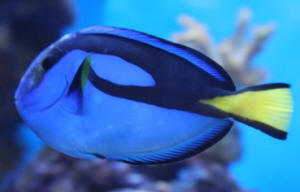
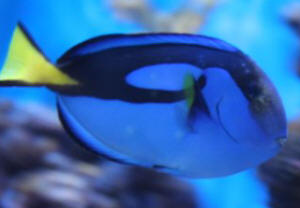
|
Surgeonfishes: Tangs for Marine Aquariums
Diversity, Selection & Care
New eBook on Amazon: Available
here
New Print Book on Create Space: Available
here
by Robert (Bob) Fenner |
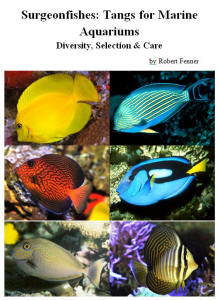 |
|
Regal blue with issues... 3/29/18
Hi Bob,
<Matt>
I've recently inherited this regal blue tang.
<I see>
He is now in my quarantine system (I am a service/maintenance business owner).
<Ahh! I did this for a few decades; retired on investments made with savings
from install and upkeep>
I handle a lot of fish and have lots of experience with Cryptocaryon,
Amyloodinium, flukes, etc.
I know that first of all, he's got some serious hlle, but back towards his tail
are multiple "pits" not along the lateral line, and sticking up out of some of
these pits is something that is highly visible above the skin.
They do not appear to change in location over the course of a week.
<They won't... improve or get worse quickly>
I haven't seen these before and I'm wondering if you had any
recommendations as for treatment.
<Mmm; yes. There is to date quite a bit of controversy re HLLE condition,
cause/s... Is there a protozoan component? Carbon? Is this mostly,
pretty much a nutritional deficiency syndrome?>
I've started dosing his tank with Metroplex every other day. He only seems to
eat flake food, not the Mysis, brine or Calanus also offered.
<Mmm>
He is currently in a bare bottom, cycled 20 gallon qt tank.
Thank you!
-Matt Parsons
<To grant you useful input, overview, let's have you read, starting here:
http://www.wetwebmedia.com/HLLEF4.htm
Then onto the Related FAQs linked above. Bob Fenner>
|
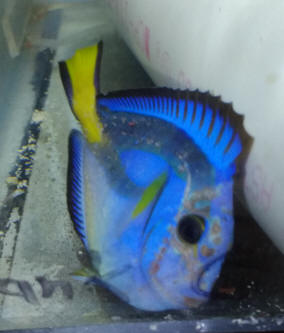 |
|
Blue tang illness 12/9/17
Hello Bob and crew !
It has been a long time since my last contact.
Lately I lost view of my blue tang and today I saw him in a bad condition.
<Eeyikes Thanasis! This poor fish is about eaten away... HLLE is the general
term...>
He has lost his blue color and he looks seek. He has not eaten for two weeks at
least. I took a photo of him and I am sending it to you in case you can advise
me what is wrong and if I can help him.
Best regards from Greece, Thanasis
<Perhaps vitamin, appetite stimulant added to the water directly, favorite foods
soaked in it. Please read here:
http://www.wetwebmedia.com/HLLESWCauseF.htm
and the linked files above, and:
http://www.wetwebmedia.com/paracfdgfaqs.htm
And write me/us back with your further observations. Bob Fenner>
|
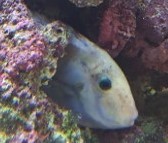 |
|
Oh, I sure hope you can help! YTBT... panic sans WWM... copper
poisoning; more 3/15/16
I have tried everything... reefcentral.com, Facebook groups, research,
research and more research and I've tried every link I can find. Hoping you
will have the answers to help our poor little Hippo Tang.
<Didn't read on WWM re Paracanthurus, but sends 3.3 Megs in pix files....>
The back-story: nearly two months ago we awoke to raised black bumps on our
Hippo. All of the other fish were fine and our first thought was he had been
stung by our Frogspawn - this is one of the first pictures. I did
not personally take this picture but it's exactly what ours looked like.
<So; these pix are stolen?>
Now, I she was still eating and seemed to be doing ok, very active and
seemed "normal" until about a month ago. We left her in the DT for another
week and decided to quarantine with copper because after posting this
picture - the replies I received was pointing to Ich because of there not
only being black spots but also white -
<.... no>
Fast forward - this is a post I posted on ReefCentral again this morning
with the photo taken this morning.
Here's a bit more info -
Black Ick or HLLE? Please help!
<Neither>
Nearly 6 weeks ago we awoke to raised black bumps on our Hippo Tang, the
night before... he was perfect. After researching and seeing that all of the
other fish were doing fine, we left him in the DT until about three weeks
ago when he stopped eating. .
He's now been in QT for 3 weeks and though we have not actually seen him
eat, we know he must be consuming something or he would have died a long
time ago. We are feeding Formula flakes in the AM and garlic Mysis in the
evening. We are also leaving garlic Nori in the tank as well.
Again, we have researched nearly every forum and have read about all there
is to read on Black Ick and HLLE but we haven't gotten the answers we need.
Should we leave him in QT with copper?
<No to copper exposure and Acanthuroids>
Shoot, we aren't even sure what we are fighting here! Most photos online are
very blurry and we can't tell if they fit his problem or not. The water
parameters are nearly perfect and the nitrates are between 5-10ppm. We've
done water changes, nearly 50% a few days ago and this morning his black
spots seem worse and though they are no longer raised like a welt, he has
black lines through his scales.
We just need someone with some experience to please help us get our fish
well again. He wants to go back into the DT and live a "Happy Hippo Life."
��
Thank you in advance.
... and, there's the recent picture -
Any help you can give or any advise that you have is greatly appreciated!
Thanks so much!
<See WWM re the species, its health, copper use, Trematodes,
Microsporideans, microscopic examination. Bob Fenner>
|
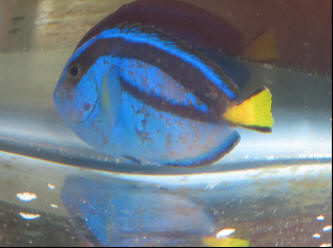 |
|
Parasites? 2/12/16
Hi,
<Kirsty>
I wonder if you can help with an issue with my regal please.
<Ah yes>
He is currently in a quarantine tank with a hello, Foxface and PJ Cardinal after
something wiped out the majority of my fish in the main tank. I originally
thought velvet due to the speed they started to die after I added corals on live
rock, which is where I assumed the parasite came in on.
<Could be>
They have been in quarantine for 13 days. Tomorrow, I was due to
transfer them to my 200l reef, whilst the main tank is fallow.
<?! I would NOT do this. The Paracanthurus has some parasite... I would treat
ALL fishes ASAPractical where they are>
All fish looked fine, but yesterday the regal started flashing against
everything. Today it looks like this. Other fish look fine.
Param.s:
Nitrite 0.2
<Toxic... needs to be zip... See, as in READ on WWM re NO2>
Nitrate 20
Copper 0.5mg/L tested 3x daily to maintain therapeutic levels throughout the two
weeks.
<A good clue... the embedded spots on this Regal Tang may not be susceptible to
Cu exposure>
SG: 1.025
Temp 26.5.
Thanks, Kirsty.
<Not much time (for your fishes)... I would def. do the drastic DROP in
specific gravity for here, right NOW. Down to 1.012, even 1.010... in the hopes
of saving your fishes. I would proceed to READ re the use of
Chloroquine (di) Phosphate (CP) on WWM and go ahead and treat with this AND an
Anthelminthic (likely Praziquantel), directly in the water. You need to act NOW.
Bob Fenner>
|

 |
|
Re: Parasites? 2/12/16
Thanks very much.
I shall start to reduce the SG now, and am picking up Chloroquine in the morning
(it's 11pm here in the UK).
I have not heard of Praziquantel, so shall have a look online and see if it's
something I can source over here.
<Yes; in the UK you may need the help of a veterinarian (or perhaps an M.D.?) to
gather both these compounds. The lowered spg will hopefully buy you time>
Many thanks.
Kirsty.
<As many welcomes. BobF>
|
|
Crypt, velvet or infection? ID help, please...
12/10/15
<Six plus megs of uncropped pix? Why?>
Greetings! I'm unfortunately without microscope and would appreciate some input
on the current malady I see in my tank if you would be so kind.
<How could I, or anyone tell from these images?>
300g tank.
About 30 SPS frags.
Hippo tang.
Three yellow tangs.
Pajama cardinal.
Six line wrasse.
Eight blue green reef Chromis.
Peppermint shrimp.
Skunk cleaner shrimp.
Tank is a year old. It was moved a year ago from being set up for 12 years
and all livestock was given away. It has all the same live rock as before.
Fish have all been in tank for four months. Corals for about 5 months, with one
being introduced 2 months ago.
Three days ago I did a flatworm exit treatment since I was
finally sick of siphoning out hundreds of flatworms with each weekly water
change. All seemed to go well, and I did a 25% water change at the end, as well
as running activated carbon in a reactor for a day and siphoning as many dead
worms as I could.
Around that time I noticed a little white area on the hippo tang's forehead.
Since then it has grown to a full white forehead and a white spot on either
side. I have attached a picture.
<.... looks like a scratch on the flank.... Physical trauma>
I don't know if I am seeing things or the yellow tangs seem like they may have a
white sheen over their whole bodies, but it is only visible when looking at the
fish from the front. From side view they look normal.
The cardinal seems fine. Six line wrasse seems fine. Chromis' seem fine,
although one of them seems to have a physical injury and a little brown spot in
the side.
None of the fish have been scratching. None are breathing rapidly. All have
voracious appetites, with the hippo tang being the most voracious. No hiding.
All swimming out in the open. Gills are not swollen.
Could you please check the picture and my descriptions and tell me if you think
it is crypt or velvet, or possibly some sort of infection brought on by lowered
immune systems due to toxins from the flatworm treatment?
<Can't tell anything from the pix, description>
I would think if it was velvet everything would be dead already, and I am ready
to try and catch all fish and place in a hospital tank and treat if it is
necessary.
<... no need to move, yes to Velvet>
Please let me know if the picture doesn't come through. I appreciate all that
you do! You guys helped immensely many years ago and all has been smooth sailing
in my tank until this incident.
Thank you! I look forward to your reply.
Thomas Bolton
<Don't panic! Bob Fenner>
|
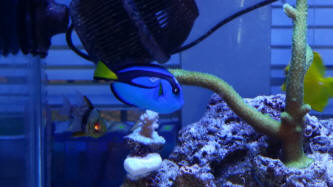
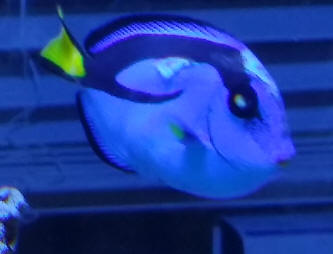 crop
crop |
Blue tang swimming vertically
5/12/15
Hi need help my blue tang is suffering from swimming problem all water
parameters are stable I currently have 1fox face 1 bubble tip anemone 1 blue
ring angle 1dr wrasse 1 blenny all are doing well currently the blue tang is in
a hospital tank
<Mmm; well... there are a few possibilities here; but am leaning toward the
Paracanthurus being stung/stuck by the Siganid or BTA.... See WWM re both.
Not much to do other than be patient, separate the PBT. Bob Fenner>
|
Help to identify and treat disease
12/4/14
Hi,
I was wondering if you know what this disease is, nobody seems to want
to guess
http://www.reefcentral.com/forums/showthread.php?t=2460931
|
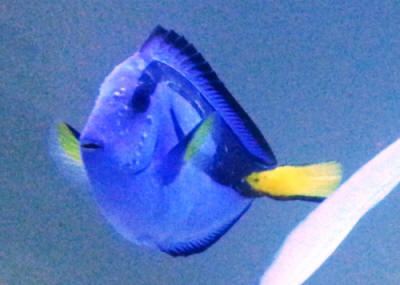 |
|
<On the Paracanthurus here I take it... Have you sampled
any of these... looked under a 'scope? Either something surface like
monogenetic Trematodes (flukes), or Microsporidean>
I took these pictures today a week later, his forehead is now expanding, I
have done extensive freshwater dips and am dosing Cupramine but no reaction
so far.
<Not treatable w/ copper>
http://www.myalbum.co.uk/Album=AXDYWLH4
|
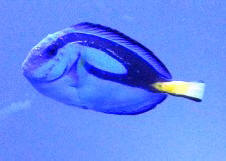 |
|
I'd really like some help with this and don't know what
it is,
Thanks in advance,
Ed
<See WWM re the above... the former are easily treated w/ prophylactic
dips/baths and Anthelminthics, the latter... not treatable as yet as far as
I'm aware. Only improving the environment, nutrition... optimizing and
stabilizing the fishs health will it be able to improve if Microsporidean
(internal) involvement. Bob Fenner>
Re: Help to identify and treat disease
12/4/14
Thank you for the quick reply, the bulging band across the forehead has
receded somewhat as four white parasites now hang out of it whereas it was a
smooth bulge before. I will have a go at the dips with some Trematode
medication and ease off with the Cupramine.
<Good; I'd give up on the copper... see WWM re this and Tangs; a poor match>
I see hypo is ineffective for flukes too and the main tank has been in hypo
for many weeks so by process of elimination it may well be flukes. Thanks
again,
Ed
<Easily identified w/ sampling, microscopic exam... and just as easily
eliminated. READ on WWM re.
BobF>
Re: Help to identify and treat disease
12/7/14
Hi Guys unfortunately not looking good at present. Video update here
http://youtu.be/a4WdG0B_cCc
<Mmm; Paracanthurus looks like it's developing HLLE, the Y. Tang breathing
hard... rest of fish look fine; but a Clown Trigger (dangerous; will kill
other fishes in time), and a hamlet/sweetlips?! Not easily kept>
Have dosed with
http://www.aquarium-munster.com/en/marine-water/remedies/gyromarin.html
<I see; a product of Praziquantel>
3 days ago as recommended in case is Trematodes but now yellow tang looks
like is bleeding from lateral line and heavily infected with growths causing
craters too.
<Yes>
Blue tang continues to be disfigured as the 'parasite' erodes deeper,
especially in the face, and dotted sweetlips also affected
with holes appearing in his head over the top and underneath gills. The
purple lips Flagfin has a single dot on the forehead that has been there
about a week but the join of his pelvic fins is blood red. Bannerfish eats a
few bits off the yellow tang on cleaning service and clown trigger seems
largely unaffected. The setup is about 2 years old but never had such a
difficult issue. It is about 3.5 weeks into the infection. Is fish only
setup with uv, protein skimmer (both off for 3 days on meds) and sump filter
tank below so any meds can go in the display tank. Anything else I might
try? I don't have a scope unfortunately. Thanks Ed
<The scope; as originally stressed. There's very little sense in
"treating" for something you don't know. Perhaps a download and
reading of the second ed. of Ed Noga's "Fish Disease; Diagnosis &
Treatment"... you can get from Amazon.com for a nominal charge for the
e-version. Call around; some fish stores, colleges w/ bio. depts. will have
microscopes, folks to help.
Bob Fenner>
Re: Help to identify and treat disease... Flukes
12/7/14
Thanks Bob, I tested all the water parameters and found nitrite had
shot up, no ammonia or nitrate, so did about a 50% water change and redosed lost
Praziquantel. Ca, Mg and pH all on low borders but probably because is slightly
hypo still. I did 5 minute freshwater dips of the Sweetlips, yellow tang, blue
tang and Flagfin with Paraguard. The majority of the infection dropped off the
yellow tang this time,
<Preserve some... just with distilled clear alcohol if nothing else... to look
at under a scope>
he is still breathing hard and his face and body look like they are covered in
acne scars now, lots of sore little red holes remain.
<Likely fluke haptor holes>
Less obvious reaction on the blue tang but perhaps less white and more
grey/black at the infected points. They all seem quite content and swimming
around since. I have upped the water surface agitation to make up for the
skimmer loss and added some Pimafix
<STOP writing me/us... READ on WWM. WORSE THAN WORTHLESS>
at the fish importer's recommendation to help the raw skin heal. I don't know if
it will do any good so long as it does not harm them but they say it works for
them. Mind you they also said vodka or white vinegar solution directly on the
infection works but will leave that as a last resort.
<....no>
Regarding the Sweetlips I have found him one of the hardiest fish I have cared
for since had him the past six months. He fed on pellets ravenously from day
one. I have read a lot of people saying they drop dead quite quickly without
reason but six months in he is growing well and has dodged ich when it affected
other fish. I am just concerned he will need a lot more space. I see the Persian
Gulf is the edge of his natural habitat so in a worst case scenario I'd put him
back to sea - as am based in Dubai.
<Don't do this. NEVER return captive organisms to the wild... too much chance of
introducing other undesirables>
So far I would have recommended him to others as a starter fish were it
not for all the chat about how difficult they are on forums. Seeing as they seem
a rarity in the US perhaps they were just caught with too much cyanide and
didn't last long. The local Filipino fish shop owner always say they are a very
strong fish and easy to feed. Time will tell. Thanks for all your help, really
appreciate it and will get the recommended book, I did a fair bit of reading of
the Merck Veterinary Manuals which was interesting and a good free resource too
http://www.merckmanuals.com/vet/exotic_and_laboratory_animals/fish/parasitic_diseases_of_fish.html
<Ahh; thank you for this>
. Scope might be a tougher purchase in Dubai.
Best Regards,
Ed
<Mail order if nec. B>
|
Tangs and Skin Troubles
1/26/14
After 17 years in the hobby I am for the first time ever using a
quarantine tank before adding animals to my newest tank build. I have
had a 2.5 inch regal tang
<Wow; small for a Pygoplites... an Indo-Pac. specimen? From... where?
Makes a diff.>
and a 3.5 inch achilles tang in a 65 gallon QT for 2 weeks. The tank was
fully cycled and has plenty of hiding places/toys (all parameters
perfect for QT). They were healthy in all appearance upon arrival, but
after a week the regal began to show white spots ( can't say it was any
Ich I am familiar with but who knows and no pictures as they won't hold
still long enough for cell phone) on and around his head. Also along his
body on both sides appeared to be tiny bumps under the skin.
<Have to sample; look under a 'scope...>
There are minimal attempts at scratching. None of what I'm seeing is
anything I've experienced through these many years. I've never
experienced marine velvet, but there are no rapid breathing symptoms,
evenly speckled dust, or any goldish hue. This didn't help me feel good
about my decision to QT instead if ye ole tried and true natural rock
and cleaners, but now I am in it, I have to move forward along
this path. I decided to use Cupramine (in spite of the fact that I had
an achilles in there that appeared perfect) to see if whatever "it" was
would shed in a couple of days. The skin bumps disappeared, but whitish
"stuff" looking like tiny pieces of white skin (best description), again
both sides of the fish body.
Yesterday was one week into copper treatment, 4 days at the recommended
dose, both fish were still playing, swimming, and eating normally. The
achilles began to show a little tuft of white on his forehead. Today the
achilles has the tiny bumps under his skin on both sides of his body.
So... I'm going to venture a guess here and say that within the next
couple of days the bumps will disappear and whitish "skin" pieces will
appear on both sides of this fish also. Again there is minimal
scratching. Before the achilles showed signs, I was about to ditch the
copper regime and start an antibiotic. I am wondering if you've heard of
such symptoms and whether you suggest continuing with the Cupramine or
moving on to an antibiotic? Again these fish are enjoying life,
swimming, playing, and eating with minimal scratching.
Thank you so much for your time honored research and assistance, Kim
Monroe
<... I'd be reading re the use of Quinine compounds now-a-years
rather than Copper. Antibiotic/s? For what? Of no use here. Bob Fenner>
Question; moving, acclimating Paracanthurus
4/6/13
Hi there,
Thank you for taking the time to answer questions and provide a resource
for all people in this hobby.
I have a question about moving a Blue Hippo Tang from my old tank to a
new tank in my house. The six inch Tang is currently living in an
uncomfortable/stressful 55 gallon tank. The Tang is moving into a
much more comfortable 180 gallon aquarium. I am not sure how to
move the Tang. I think bagging and floating and acclimating may be
too stressful, so I was wondering if you think it may be better to try
and match the water
quality between the two tanks and then just drop him in the 180 gallon?
Or perhaps I should just bag him?
<I would move this fish in a doubled "fish bag" of size... catch it with
two nets, one for guiding... watch your hands... the tang and dorsal and
anal fin spines are painful to get stuck by>
If I were to match the water in the tanks, I was thinking salinity,
temperature, and pH would be the most important. The 180 gallon is
perfect
on all measurements (very proud of that), the 55 has very high nitrates
and will be dismantled after the move.
Thank you and I appreciate any input.
Craig
<Please read here re marine acclimation:
http://www.wetwebmedia.com/acclimat.htm
Bob Fenner>
Re: after Ich outbreak -update; Paracanthurus hlth. mostly
2/20/13
hello crew,
<Andrei>
The things have settled since my outbreak. The tank remained fallow for
4 weeks now ( 7 weeks including the time that there were only 2 Firefish
gobies in there that are now in a friends already populated tank and
doing ok, so they were not hosting Ich ).
<Not so; these Microdesmids should have been removed... were acting as
reservoir hosts>
All the corals ( including some new SPS) and invertebrates are doing
great.
And now, 2 days ago the first 3 new fishes arrived. There were QT`s
waiting for them, already cycled, with live rock, for the Chelmon
Rostratus was even a big rock full of Aiptasia from a friend that he is
enjoying a lot.
Baths with freshwater and blue methyled were made. Except for a
beautiful Paracanthurus Hepatus Yellow Belly that was almost finished
when I opened the bag ( 6 hours drive from the closest LFS).
<Wow!>
He was laying on a side and not looking good. I resisted the temptation
to put him directly in the QT and started an acclimatization for him
that took 40-50 minutes, but skipped the bath because I thought he would
not make it.
I was thinking that if he dos make it he will have the bath after 4
weeks in quarantine before going to the DT.
<Good>
After introduction in the QT that had an air pump and good water and
hiding places he just laid on one side for the rest of the night. In the
morning he was crawled under some rocks. When I lifted one of the rocks
he came up and toured the 40 gallons aquarium and then hidden again.
All he dose now is sitting in there, and trying all the time to go even
further under the rock even if there is no room.
<Not to worry. Don't disturb this fish; it will be fine>
The QT`s are in the garage, well heated, under a window, so all day
nobody bothers them, there is dawn, really nice daylight lighting and
quiet.
But he doesn't seem to ever get out from there. Not to speak about
eating something... It has been 2 days already, what should I do? He is
really beautiful.
thank you
Andrei
<Just be patient... being moved, being oxygen starved, being placed in a
small transparent container... are all frightening. Bob Fenner>
Paracanthurus eye issue 11/9/12
Hey Bob.... You know, while I was emailing you I discovered that my
hippo tang has two clear/white outlines around his eyeballs.
Almost like his eyes are being pushed out slightly and there is skin or
something coming out. What could be the cause of this?
<Likely some aspect/imbalance in water quality more than anything...
perhaps biologically mediated... When, where in doubt, change some water
out...>
Besides Epsom salt is there anything else I can do?
<See WWM re eye issues of marine fishes. B>
Thanks again
|
Blue Hippo Tang - White Covering, Fungus Or Bacteria
or Parasite - Bleeding From Gills?
3/12/12
Hello,
<Hi Adrian.>
Fish and tank have been fine for a few years. Out of nowhere the
other night I heard a "thumping" sound coming from the
tank. Couldn't figure it out. I now assume it was the hippo
tang fighting with another tank mate<Likely one of the
tangs.> or perhaps moving too fast and rigid-like in the rock
work.
The hippo tang now has white marks all over it - like someone
rubbed chalk on it... and there is a gash taken out of its tail
and near the underside of the gill. It literally looks like
someone took the end of a knife and just nipped out a chunk from
it.<They are called Surgeonfish for a reason. They will use
their spine or "scalpel" at the base of there tails for
protection or to establish dominance.>
Anyways, now it is constantly going over to the cleaner shrimp
all day long<The shrimp is removing damaged or dead
tissue.> and I just saw it trying to scratch the very top of
it's dorsal
fin. It aimed itself sideways at a rock and tried to scratch the
top of itself. What is going on here??<Scratching for lack of
a better term.>
Only new addition is a cleaner shrimp the other day (store water
was NOT added to tank) and some new corals that I dipped in Two
Little Fishies Coral Revive for 15 minutes.
Inhabitants:
Hippo Tang
Yellow Tang
Six Line Wrasse
False Percula pair
Kole Tang
snails
<How large are the tangs?>
cleaner shrimp
fighting conch
Tank Size:
125 gallon.<Dimensions?>
I also read that fish can turn white and flash themselves due to
stress. Is that so with the hippo tang? I don't understand
why it changed overnight after a few years.<The fish are much
larger now and the tank is the same size.> Could it be
stressed and white due to whatever happened a few days ago? I
also redid my rock work a few weeks ago but its color has been
since.<I suspect the tangs are fighting for territory in the
newly designed rock work.> This just happened.
On top of that, I also noticed a dark liquid substance coming out
of its gills last night, shortly after a cleaner shrimp was
picking away at its gills. Was this blood?<Hard to say without
seeing.> The lights were off so I couldn't tell the color
but at first I thought it was blood? It looked like that or
either dark black oil... but it was flowing from the gills.<If
blood is flowing out of the gills I do not think it will survive
the injuries.>
Picture attached of tail gouge and here is a video link. In the
video you can somewhat see the white covering its body. It hardly
shows up in the video but is much more pronounced in person. The
patches of HLLE were from a few years ago. I feed new life
spectrum and Mysis with vitamins etc... and do regular water
changes.<One of the tangs will likely need to be removed to
stop the fighting.>
http://s241.photobucket.com/albums/ff141/chatyak/?action=view¤t=IMG_0241.mp4
Adrian,
<Jordan>
|
|
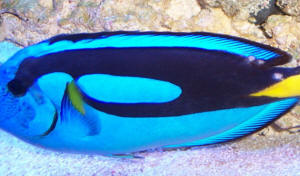
|
|
blue tang... no searching, rdg. 1/4/12
As you see from the attachment I have a blue tang who its not
doing so well.
<Mmm, yes... usually water quality and/or nutritional issue/s
are at cause here>
The tank is over a year old so this is not a new tank. There are
2 clown fish in there with her and they have no visible
problem.
<A good clue... able to rule out much in the way of possible
environmental causes>
They all seem to get along. She started her fin decay a few
months ago and I took a water sample to the local aquarium store
and they tested it. They said it looked like my tank was
cycling but other than that everything was fine.
<Toxic/debilitating while cycling>
If everything is ok in there and she is the only one with the
problem then I feel it is probably not my tank. But I do not know
that as I am fairly new to all of this. She eats fine (on most
days) and comes out to play and check things out. Can you please
help. Thanks!
Regina
<Umm, yeah. Please learn to use the search tool and indices on
WWM. Read here:
http://www.wetwebmedia.com/YTBTDisF9.htm
and the linked files above else-wise. Bob Fenner>
|
|
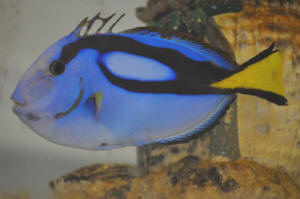
|
|
Blue Hippo Tang flesh being "eaten" away
11/28/11
Hello,
I have a Blue Hippo Tang, purchased as a juvenile about 2 years
ago. She has had no history of health or behavior issues.
We feed flakes daily, Mysis shrimp a 2-3 times a week. We have
about 9 fish with live rock, urchin, starfish,
crabs, no corals. Tank is 90 gallons, recently
checked water quality and regular water changes. Tank has been
stable and healthy for over 2 years. Last fish added was a Lunar
Wrasse about 3 months ago.
<Mmm, well... ninety gallons... nine fish is too much...
something/one has damaged this Tang... maybe the Thalassoma
that's new, perhaps a run-in w/ a rock or the urchin... now
the crowded/polluted conditions are conspiring to aid bacterial
decomposition of your Paracanthurus>
About 2 weeks ago, the Blue Tang had a few "scrapes" on
it's side, as if she had scraped along the rocks.
<Ah yes>
They were gone in a day or two and no other marks showed up from
that. I noticed our female Blue Jaw Trigger had similar feathery
like scrapes on her head for a couple of days. Her's have
gone away as well and she still seems fine We left town for 2 1/2
days (fish were fed flakes while we were gone.) We came back to
find the Blue Tang with a white faded spot on her side, about the
size of a quarter. She was breathing hard, swimming erratically
and could not stay straight. She would flounder to the side while
on the bottom, and would quickly head to a corner at the surface
or under a rock where she could straighten herself. Within hours,
I noticed pitting in the white area. The next morning, there were
red areas where the pitting was. It has since grown at an
alarming pace, and it appears she is being eaten by something
from the outside in. Her breathing is a little better, she is
eating, but not as much as usual. Her other side is fading a
little, but not yet resembling the other.
We have treated with StressCoat,
<Of no use here>
feeding Nori seaweed (she hasn't eaten that yet) and putting
Focus and Metronidazole in food
<Why? Id est, for what presumed reason?>
(frozen Mysis shrimp.) She is eating a little, eating more of the
flake food than the shrimp. We unfortunately do not have a
quarantine aquarium set up.
<No need; have to fix the environment/world all are in
currently>
If there is any shot at treating this without setting one up,
please advise. Picture attached. This photo was about 32 hours
after first coming home to a the large white spot on her
side.
Thanks!
Christy
<What measure for Nitrate here? Do you have a skimmer? When
last cleaned?
Do you use chemical filtrants? Don't know exactly where to
refer you to for reading. Let's try here: http://www.wetwebmedia.com/infectio.htm
and the linked files above. Bob Fenner>
|
|
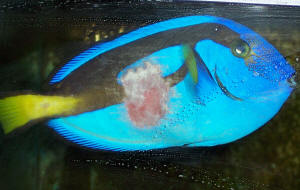
Re: Blue Hippo Tang flesh being "eaten" away
11/28/11
Hello,
<Christy>
We bought and used the Focus and Metronidazole in the food by
suggestion of the tropical fish store owner in our area. He said
it would take care of the bacterial infection he diagnosed this
as.
<... is bacterial highly likely, but secondary... The med.s
have no chance of treating this>
I also read (I've read a kazillion confusing articles) to use
the Nori seaweed as a nutritional value, to be sure the Tang was
getting the nutrients it needed.
<Actually, such algae have almost no nutritive value>
Her wound has "whited" over today and I am hoping that
is a good sign. She is staying hidden behind rocks.
I agree, too many fish, the last added (Wrasse) was too much. He
is a large fish and in my opinion, too aggressive in our
tank.
<I do agree. Would remove post haste>
We are going to remove him asap and return him to the store. He
is difficult to catch, this will not be easy.
<Two nets... maybe four... w/ two people>
He has a good protein skimmer and a water filtration system, no
chemicals.
I'm sorry I have no idea what it's called, that's my
husband's area and he's at work. He does regular weekly
10 gallon water changes, did one early last week. He checked
nitrates and phosphates on Saturday, I recall the phosphate being
a 2,
<MUCH too high. Please read on WWM re HPO4>
unsure of nitrate level. He only told me his water quality was
okay.
We were also recently told to add Melafix
<Worse than worthless... may interrupt nitrification. PLEASE
learn to/use the search tool on WWM ahead of actions and writing
us>
and did so earlier today. Do you agree with this?
<NO. Would add a modicum of activated carbon to your filter
flow path to remove ASAP>
It has also been suggested that this was caused by aggression.
Though my memory goes back to the scrapes on the Tangs sides a
few weeks ago. I also remember a day or two before that, our
female Blue Jaw Trigger showing a "feathery-like"
scrape on her head. It was there for a few days. It did not look
like a bit or hit, it looked like a scrape. She seems to be fine,
as of now.
Thank you Bob for your help. I have been overwhelmed trying to
find the reason for this and the solution online.
<Glad to help you and your livestock. BobF>
|
Re: Blue Hippo Tang flesh being
"eaten" away, Thalassoma
incomp. 11/29/11
Hi Bob,
<Christy>
Thank you for taking time to answer my questions and give
some guidance!
The Lunar Wrasse is the confirmed culprit.
<Ahh, yes; as I originally suspected>
I witnessed it attacking the Blue Hippo Tang, took many
chunks out of her.
The Wrasse was immediately separated from the rest of the
fish and has been returned to the store.
<Good>
The Blue Tang has been out since and seemingly peaceful.
Now it's time for healing her wounds, (new picture
attached) and getting her healthy. We read the articles you
mentioned (plus some) and added activated carbon as you
advised and going to work on getting things back to where
they should be for a healthy environment. No more new fish
for our tank, lesson learned (the hard way, as usual.)
Thank you again, you are well appreciated.
Sincerely,
Christy Young
<Thank you for this follow-up. Cheers, BobF>
|
|
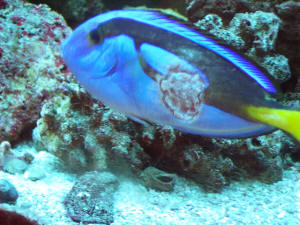
|
|
fin and head erosion on regal
tangs 9/7/11
Hi,
<Hi Judith>
I appreciate your taking my question.
<No worries>
One of the staff members at the marine shop where I trade came over to
look at my aquarium. My two Regal Tangs have had erosion on their faces
for over a year and their tails were torn. I had thought this was
because they were scratching their faces on the rocks and perhaps
biting each other's tails.
<No>
The staff member said he thought is was nutritional <and/ or
psychological/ environmental> and said he thought they had head and
lateral line disease.
<Yes>
I thought about how I had previously taken care of Tangs before and
remembered I used to put Boyd Vita Chem on the food before feeding. I
started doing this in March. It is now September. I have seen a very
little improvement.
<This needs to caught early, while the erosion is white in colour.
If the erosion colours to the skin colour of the fish then it is rarely
healed up>
In early August, the shop suggested Selcon drops that I am now
using.
<Good>
Still not much improvement. I have a copy of your book the
Conscientious Marine Aquarist. The book says the vitamin supplement
needs to have vitamin D in it.
<And C. You can add your own to the vitamin mixture. Also look for
Beta Glucan at the health food shop>
I could not find the content on the bottle of Selcon drops. The Vita
Chem says is has D-L Phenylalanine 3.0MG, D-L Isoleuline 2.0MG Crude
Fiber 2 per cent and D-L Tryptophan 1.0MG min crude fat .09 per cent.
Is this what you mean by vitamin D?
<Mmm, not sure, have you Googled this? Baby vitamins (the drops)
should have this vitamin>
If it isn't, could you please recommend a specific vitamin
supplement I can buy to help my fish?
<Feed them New Life Spectrum Pellets. The single best HLLE
'healer food' I have used.>
I have been feeding them live algae from the shop and frozen brine
shrimp.
<This needs to be soaked in the vitamin mixtures & fed alongside
the NLS pellets>
Along with Cyclop-eeze once a week, and Thera +A, and Ocean Nutrition
Formula Two Flakes with Garlic daily. The chemistry of my tank is
usually ph 8.1, kh-13, cal 380-400, phosphates-0, nitrates-10. spg-23,
temp 76.0.
Any help you can suggest would be greatly appreciated.
<I do think Judy that a fish that has had the condition for this
length of time might well be permanently scarred unfortunately>
Thank you,
<No problem>
Judy Jenkins
<Simon>
re: fin and head erosion on regal tangs 9/10/11
Hi Simon,
<Hi Judy>
Thank you so much for your help and for answering so quickly! I
appreciate it very much!
<It's a pleasure to help>
Sincerely,
Judy Jenkins
<Thank you, Simon>
|
Sick Blue tang... no rdg., mis-using WWM
6/13/2011
Hi Guys,
<19 megs of pix... DO pls follow instructions... no one has
responded as your files are too large>
I have a Blue Hippo Tang that has brown spots on the black area
between his tail and blue oval.
<Stress markings>
I have had him in my 30 gal. qt for about a month trying to
diagnose and treat him.
<Place this fish in a proper environment>
I've use 1 cycle of furan-2,
<Of no use here>
several fresh water dips, and am now using copper.
<An exceedingly poor idea w/ Acanthuroids... much too toxic.
Not only have you abused our mail server w/ too much blurry pix,
you haven't read on WWM ahead of writing us>
Please see the above photos. I realize they aren't the best.
The brown spots are flat and look like mud or dirt spots. The
fish eats a ton and acts healthy. I would greatly appreciate you
opinion.
Best regards,
Todd Zevchik
<Read here: http://wetwebmedia.com/paradisf6.htm
and all the linked files above. Bob Fenner>
|
|
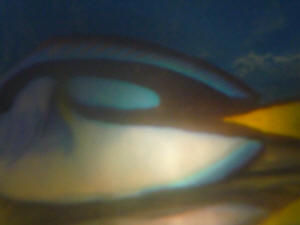
|
|
re: Sick Blue tang.... still not reading
6/13/2011
Sorry about the pics. My computer is having some problems. I did
read before I sent an email, but didn't find a specific
enough answer. Do you suggest removing the copper (dosed at
1.5)?
<... Please just read where you've been referred to... NO
free copper period is advised w/ this fish, these fishes>
Should I place him in my main tank as is?
<Yes I would>
Thanks,
Todd Zevchik
<BobF>
re: Sick Blue tang 6/13/2011
Thank you for your help and information.
Thanks,
Todd Zevchik
<Welcome. B>
|
|
Re Tang Selection 1/28/11- 1/30/11
<Hi Dave>
So a Hippo arrived yesterday 5-6 inches. After the worrying lying
down phase yesterday he's happily swimming around in the QT
and eating well.
Below a shot of him attacking the Nori.
<Nice specimen.>
I have one question though that I'd love your opinion on: On
just one side of his head he has a couple of areas that are
eroded/pitted which were there on arrival (saw when in the bag).
I worry whether this is a problem such as remnants of a
disease/parasite or something new. I've seen some pics on
line of HLE but it doesn't seem that bad.
<May just be the onset of HLLE but not unusual to see this in
larger Blue Tangs. Bob may comment here as well.>
The supplier I got him from (he came by FedEx) says they have a
tendency to dive into the rocks when they catch them and it's
probably that and they didn't notice it before shipping.
Looking at the pics what do you think?
<Maintain good water quality and suggest adding a vitamin
complex such as Selcon to the food, continue to observe. Too soon
to be overly concerned.
I like the first pic, nice. James (Salty Dog)>
|
|
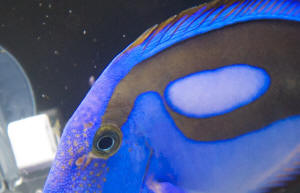
|
Cure for Hippo Tang- white spot and bulging eye
1/17/11
HI Bob/crew
<Srinivas>
Srinivas here form India ( again)
Hope you would help me as usual.
My hippo tang has caught some problems.
1) He has a very tiny white spot (just one) on his body
<Mmm, not a worry... this is likely a "point"
irritation... from maybe getting poked or running/swimming into
something>
2) he has a slight bulging eye c(right one) and a white spot there
too.
<This too is probably due to a physical trauma>
He is in a 200 G FOWLR with
about100 pounds of Live rock and 150 pounds of live sand.
To give him company are
1 Yellow tang
1 Koran angel
1 Oscellous clown
1 Tomato clown
2 green Chromis and
1 Long tentacle anemone
<Could be a tussle w/ the Tang, Angel, the Anemone...>
He is fed with Brine shrimp, Purple Seaweed, ocean free Marine pellets
<Which/what brand? A plug here for you to try/use Spectrum if you
can get hold of it>
and tetra bits.
He eats normally (aggressively) swims elegantly and had shown no signs
of stress.
<Ah, good>
I just noticed the bulging eye just an hour ago (not even an hour). A
recent development I can say.
Please help me to know:
What is this exactly?
What might have caused this?
<See above>
What's the remedy/cure?
<Just good care, feeding, time going by>
Can it be treated in the display tank? ( seems impossible to catch him
in the set up with rocks)
<No need to catch, more, or treat. If you feel compelled to spend
money, buy something useful, look to food supplements like
SeaChem's Reef Plus>
Thanks in anticipation
<Welcome! BobF>
Re: Cure for Hippo Tang- white spot and bulging eye
1/20/11
HI Bob
<S>
Just cant relax with the white spots still on.
The hippo seems to take its time to heal. The swelling in the right eye
has decreased but now I can see two tiny spots on the eye. The right
eye has now caught up and has one big sot right in the middle. The body
has acquired some more white spots.
The yellow tang has shown a bit of stress. On a closer look , I found
two very minute white spots on one of its fin. Rest is all OK
NO abnormalities of any sort noticed.
All fishes are active and feed normally.
Please help.
Is there any medication I can use in the display tank to avoid further
spread?
<... please read on WWM re Cryptocaryon, infested systems...
BobF>
Hippo tang acclimation 1/3/11
Hi Crew
<Hello Jim>
I have just run my main tank fallow for 5 weeks to reduce parasites to
a minimum after and Ich infestation claimed my previous livestock.
I have had a flashback gramma and a hippo tang in quarantine for 6
weeks.
Today I put them both (disease free) into the main tank.
Straight away the hippo tang has made for some rock work and has not
moved all day. He was displaying this in the Q tank and he has done
this before as the Q tank was only 15 gallon and the gramma was a bit
boisterous.
Should I be concerned the tang is sick? I know hippo tangs are very
timid on introduction...
<I would not be concerned... Paracanthurus DO hide a great deal on
introduction. It may not come out much at all for the next few days. I
urge patience. Bob Fenner>
Your thoughts please
Jim
Re: Hippo tang acclimation 1/4/11
Hi Bob
<Howdy Jim>
Thanks for the feedback. Tang has come out briefly today but is still
hiding
and breathing quite heavy. I did read on your site you do not recommend
quarantining this fish. Is this correct?
<Generally the case, yes. A decision that one must make w/ each
specimen... whether the duration and stress of quarantine is likely to
"get you more" (or save you more) than cursory dip/bathing.
Tangs in general are a family of fishes that straddle the line here...
often delaying their placement results in more trouble,
morbidity/mortality than simpler preventative MOs>
Your thoughts please.
Jim
<Is this clear, complete? BobF>
Re: Hippo tang acclimation 1/4/11
Yes Thanks Bob
<Welcome>
The tang still displays clear stressful behavior and the rapid
breathing is a concern. I think at this case it's a wait and see
approach.
<Good. Is what I would definitely do>
Thankfully so far the main display seems to be Ich free.
<Ah good. BobF>
Re: Hippo tang acclimation 1/5/11
Hi Bob
<Jim>
The tang has thankfully come out to feed now. However it has developed
Ich again (I think). I am dismayed as the main tank was left fallow for
a month and the tang was totally parasite free when it was placed in
the display tank.
<I would not over-react here. Would leave this fish where it
is>
Currently it only has a dusting of 4-6 tiny spots and they are
virtually unnoticeable. I fear putting it back into the QT tank is
counter productive as it will probably stress it too much.
<These spots may well not be Ich... even Crypt is not
"spots", but the host fish's mucus reaction to
irritation. Again, I urge patience. BobF>
Your thoughts please.
Thanks
Re: Hippo tang acclimation 1/6/11
Thanks again for your advice Bob
<Mmm, am not inclined to actually give advice; rather, just state
what I'd likely do given the information presented and what I
"know">
Sadly I woke up this morning and the tang has more spots. The royal
Gramma is unaffected. This does look like an Ich infestation.
<So?>
Clearly the Ich in my tank is still present. Perhaps four weeks was not
long enough.
<Perhaps>
Isolating the tang again doesn't seem a good idea at present do you
feel?
<Please read here: http://wetwebmedia.com/parasittkfaq2.htm
and the linked files above. Maybe adding a biological cleaner would be
of use here>
Rather let nature take its course. I fear a total strip down may be
necessary.
Many thanks Jim
<Welcome. B>
Re: Hippo tang acclimation 1/6/11
Thanks for the links Bob
<Welcome>
Have digested/cogitated before and still again.
If I remember rightly the last Regal tang I had in my old tank broke
out with Ich, but it made it through with the help of a UV sterilizer
(and the removal of a bullying Trigger). I am currently dosing ozone
instead, but may add a UV to assist (the only problem is they push my
temperature up too high in summer months).
Just to be sure of your opinion would you leave the fish and make sure
parameters are optimal? I really am a little frustrated that I have
followed the gold standard of QT and letting go fallow and been
rewarded like this.
<I would very likely just leave all there for now>
It is this experienced hobbyists opinion that even an apparent
'fallowed' tank still retains some Ich protozoa ready to attack
compromised/stressed fish.
<Yes it is generally>
Regards Jim
<And you, B>
... Hippo tang, Crypt 1/8/11
Hi Bob
<J>
Just to keep you informed. The tang continues to suffer with Ich (4
days after introduction) . He feeds ok and the royal gramma is
seemingly unaffected still.
<Ok>
As I only have one quarantine tank (which is full with a maroon clown
and some neon gobies) and a fish trap what do you suggest is the best
long term solution in my display now?
<... still reading, just waiting>
I am still dosing ozone and am tempted with a UV.
<Have any idea what your RedOx is?>
Many many thanks.... I still have your conscientious marine aquarist
book.
It is however well studied and falling apart a bit.
<Mine too. BobF>
Blue Hippo Tang Quarantine tank 12/2/10
Good Afternoon Crew,
First of all, I would like to thank all of your efforts and hard work
which allow hobbyists such as I to have access to the vast knowledge,
experience, and information that all of you poses.
<Welcome>
I purchased a 2-2.5 inch Blue Hippo Tang yesterday evening, and after
bringing him home, I gave him a 10 minute fresh water bath,
<pH adjusted?>
and set him in my 10 gallon quarantine tank. My quarantine tank is just
a bare-bottom 10 gallon with a hang-on filter and a heater. At first he
ran to the corner and settled down, breathing quite heavy. I assumed it
was normal behavior for a stressed fish, and let him be. I realized now
that I should have turned the lights off in his tank, to help calm him
a bit more.
The lights were on in his tank for approximately another 3 hours, and
when I went to go turn them off, I noticed he was wedged behind my
heater and the pipe from the filter.
<Typical behavior>
Started by this, I swished some water on to him to check if he was
still alive, and realized then that he was probably just looking for a
place to hide, so I threw in a small rock, and led him to it, so that
he could hide
inside. I turned off the lights, hoping to greet him in the morning
with some food.
When I saw him in the morning, he was still hiding behind the rock, in
a very particular position. He was hanging vertically, with his head
facing the bottom of the tank, and was still breathing quite
heavily.
<Not unusual>
Disappointed by his lack of adjustment into my tank, I tried to feed
him some HBH veggie flakes anyway. He didn't even seem like he
noticed, although my false percula clown (in the main tank) goes gaga
for them.
He is still hanging in that vertical position, and now I am wondering
if its because the bare-bottom of my tank is creating a
"mirror" effect, and he thinks there is another blue tang
there?
<Mmm, no; not likely>
I'm assuming this isn't normal behavior, even for a stressed
tang, to be swimming in such a position?
<Not unusual>
Even for the few seconds that he left the rock and swam out for a bit,
he was still hanging vertically, with his face to the bottom, and as
soon as he spotted me, ran back around and behind the rock once
again.
Water levels:
Ph: 8.1Nitrites: 0Ammonia: less than 0.3 Salinity: 1.023
<Mmm, I'd raise this>
Temp: 77
After putting him into the quarantine tank, I looked at your "
http://www.wetwebmedia.com/paracant.htm"
section, which states not to quarantine blue tangs due to the stress
levels that all the moving may cause. Should I not have put him into
the quarantine first?
<Only if you had concerns... By and large I dip/bath and place this
species sans quarantine. Most all that can/could be gained by isolation
is provided for in dipping (removal of external parasites)>
Forgive me for the long read, I am just trying to supply as many
details as possible.
Thank you in advance for your response,
Cheers,
Fahd.
<Welcome. Bob Fenner>
|
Sick Hippo tang 11/04/10
Hi WWM Crew,
<Hi Kate>
I recently found your website and thought you might be able to
help/advise me on my current situation.
<Ok>
I bought a 2.5" Hippo tang about 8 months ago and put it in
my 29 gallon tank
<? This fish cannot live here>
with an 8 year old Clown fish (I stupidly did not
quarantine-rookie mistake but neither fish had any ill effects
from it thankfully. I bought a small quarantine tank after that).
5 months ago, I bought a 130 gallon fish tank and let it cycle 2
months sans fish.
<ok>
I have 150 pounds of live sand and about 30 pounds of live rock
in it. I have a SeaClone Protein Skimmer 150, a Fluval 304, a
Rena Filstar XP4, and a heater.
<Mmm, would look to swapping the canisters out, and just
utilizing live rock for filtration here>
I change 25-30% of the water every 3 weeks.
<Good regimen>
I bought a Yellow Tang shortly after setting up the 130 gal tank
and put it in a separate, smaller 10 gallon quarantine tank.
After the 2 months of cycling, I introduced the Yellow Tang to
the main tank first (he was getting stressed from being cramped)
and he has done marvelously since.
<I would have placed the Paracanthurus first here, the
Zebrasoma last>
Next to be introduced was the Clown fish about 6 weeks later,
again with no problems. 2 weeks ago, I introduced the Hippo tang
to the main tank.
<Should have been the first fish, or perhaps second after the
clown>
She hid for about a week before coming out (she was stressed and
she and the Yellow Tang did not get along initially)
<typical>
but seemed fine after that until 2 days ago. She had what looked
to me like classic Ich, little white bumps on her skin, maybe
12-15 of them. I immediately removed her to quarantine (44 gallon
Rubbermaid container) and started treatment with Kordon Rid-Ich
(Malachite green chloride salt and 11.5% formalin).
<This action was pointless I'm afraid Kate. Even if you
manage to rid the Paracanthurus in QT of the parasites, you are
only re-introducing it to an infested system that has an
incumbent Zebrasoma with it's territory marked. Your problems
will repeat themselves, I would have either left this to see if a
balance could be struck with these parasites, or removed all of
the fish for treatment w/ a fallow period.>
Yesterday, her white spots looked like they had flattened out so
I thought the parasites had dropped off of her and continued
treatment, but today she looks like a different fish entirely!
Her eyes are slightly cloudy, she has what looks like a white
film on her sides (the white spots are completely gone), is
lethargic, breathing heavily despite extra aeration and splitting
her time gasping at the top or laying on the bottom. I'm sure
by the time you respond to this she'll probably have already
died. It breaks my heart. She's my favorite fish by far.
<'¦ small qt tank therefore poor water quality,
chemicals present, stress'¦ death of fishes>
I don't understand how she went from fine with a few spots to
near death in so short a time.
<You introduced her to an infested system with an incumbent
Tang>
Do you think having her by herself is making her worse?
<Yes>
She seemed to get drastically worse after putting her in
quarantine and treating her for Ich... Should I continue
treatment, change treatment (if she's still alive)? I'm
not sure what this could be. I'm also concerned for the other
2 fish in the main tank. Neither are showing any signs of disease
yet. I don't know where I went wrong and how she got whatever
she has. Any advice would be greatly appreciated!
<Would place the fish back to display system, in the sump if
possible, away from the others to recover while you ponder your
next move>
I attached a picture of the Hippo Tang in a clear plastic
container so you could see her.
<Yes.. ragged fins like that are sure-fire indicators of poor
water quality, poisoning, and the cloudy eyes'¦ this
QT system & it's water is not suitable for this
fish>
Kate
<Simon>
|
|
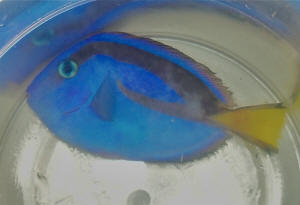
|
|
blue tang disease 10/26/10
Hello,
<... Hi there>
My Blue Tang has some discolorations on half of his body.
<... these markings and erosive condition are evidence of poor
treatment...
Water quality/environment and nutrition>
Today I noticed the red spot on one side closer to his tail. This
must be some parasite disease and not just his age. What do you
think by looking on his pictures? He is more than 8 years old but
this looks like some disease to me. He has lived in this tank for
a long time and there were no any major changes to the tank
recently.
Thank you for your help,
Tanya
<... Read here: http://wetwebmedia.com/YTBTDisF8.htm
and the linked files above. Bob Fenner>
|
|
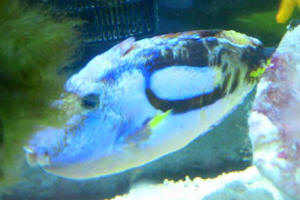 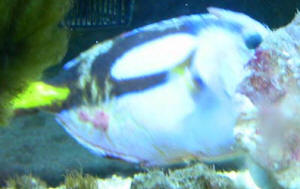
|
help my blue tang has hole in the head 10/4/10
<Do read here:
http://www.wetwebmedia.com/paracant.htm
Among the Surgeonfish and Tangs generally, Hole-in-the-Head and
Head-and-Lateral-Line-Erosion diseases are strongly associated with
poor husbandry. In particularly poor/monotonous diet (lack of fresh
"greens" and their associated vitamins) and poor water
quality. Review maintenance and diet. Improvements to both, including
the use of vitamin supplements, can cure light to moderate outbreaks.
Bear in mind Surgeonfish are 90% herbivores in terms of diet and live
in shallow water, highly oxygenated
surf zone environments, and need to be maintained accordingly.
http://www.wetwebmedia.com/hllefaqs.htm
http://www.wetwebmedia.com/hllefaqs2.htm
Cheers, Neale.>
help my blue tang has hole in the head
what kind of vitamins should I get for my tang and where can I get
them
<Are we economising on gratitudes. salutations and? Be that as it
may, all this information is in the articles I linked you to. The
required vitamins, brands you might use. Cheers, Neale.>
blue tang question 9/25/10
At my local fish store, I saw a small (about 3") blue tang. It was
one of the most active ones that I have seen in a long time at the
store. Anyway, it had one issue that concerns me, and I am not sure it
is actually a problem. I have noticed many times in blue tangs that
their stomachs have a lumpy appearance to them. I'm not sure what
that means.
<Most often that they've swallowed a bit of hard substrate...
this is natural, serves as a triturating surface... for
"chewing". Not a worry>
Not sure if that is significant or not. Otherwise, he seemed very
healthy. He was very alert to my presence, very active. Do you think
this fish could be sick?
<Not really>
What does a lumpy stomach mean?
<That this animal has picked up, swallowed some
"gravel".>
Thank you for your help! Mike
<Welcome! I would not have this criterion/observation alone deter me
from purchasing this specimen. Bob Fenner>
HELP (need advice to save) big Sick 6 year old Hippo Tang...
9/15/10
Hi,
<Hello Pam>
Rick & I have a Regal Tang that we have raised from a 3/4 inch
(skinny, ribs showing, full of Ich, sickly) fish to a big 8 inch fat
fish. . .
After returning from the MACNA convention in Orlando, we were told that
he had not been eating from the time that we left for Florida. No new
fish or corals had been added to his tank (with 4 other tank mates) for
over a year. He has had Ich from time to time, but not recently (that
we know of). The clown, Kole tang, purple tang, and copper band
butterfly fish that he shared his tank with are all fine & have
never been ill as far as we know.
<Mmm... summat it ate...>
He cannot swim properly, but when he does, cannot elevate off of the
sand, then flops over with back arched and lays on one side. He lets me
know he is O.K. by moving his pectoral fin that is on the top side when
I approach. When I try to feed him he closes his mouth. Otherwise his
mouth is open when he is lying there.
He has no pectoral <likely you mean lateral> line damage, and his
fins appear to be in perfect shape. To see him, you would not know that
he is extremely ill or hurt except by his "posture" (arched
back & lying on one side). When he manages to swim, he scoots along
the bottom of the sand until he exhausts himself & flops over on
one side or the other. His color, so far, is excellent, but I am
terribly afraid that he is going to die.
None of the other fish that were with him in the tank are or have been
sick. We have not "lost" any fish in quite some time, and I
would love to save our Blue Hippo Tang... We did move him from the tank
with the other fish to a separate 105 gallon tank that had no fish in
it, so that we could see him and hopefully treat him.
I have been dosing garlic and Marine Max, with Omega vitamins, too, for
several days since returning from Florida. But he does not seem to be
improving rapidly, if at all, and he will not ( cannot?) eat.
<Again, my first guess, given the stated history, types of tankmates
and their apparent health is that this fish has ingested something
toxic/damaging...>
Do you have any suggestion and / or advise <advice>? All of the
water parameters are in order.
Pam Erickson
Dynamic Coral, Inc.
<Unfortunately, only patience, time can/will tell here. I would not
expose this fish to any chemical treatments. Bob Fenner>
Re: HELP (need advice to save) big Sick 6 year old Hippo
Tang... 9/16/10
Thank you for your prompt response...
<Welcome Pam!>
By the way, we really enjoyed your speech at the Dallas Ft. Worth
Marine Aquarium Society recently and your appearances and everything
you had to say in Orlando, Florida. Your presence is always fun &
your knowledge of all things aquaria is always appreciated. I'm
sorry I didn't say that earlier, but I have been in a desperate
hurry to save my blue friend.
<I understand>
Before receiving your reply, we went ahead & quarantined him in a
20 gal. bare bottom tank to have a closer look, since he wasn't
totally viewable in the 105 gal. where he managed to wedge himself
between the rocks.
<Not atypical behavior... in the wild or captivity>
Now that we've had a closer look, he does appear to have a very
small white area on the leading edge of his left pectoral fin...
<Mmm, I would move this fish back to the main system... continue to
offer favoured foods, soaked in HUFA/Vitamin supplement>
I did mean to say that his lateral (not pectoral) line looks fine (as
you so appropriately noted in my earlier letter to you.) And his
lateral line still looks pretty good.
<Ah, good>
Is it possible that the small area on his left pectoral fin could be
evidence of a larger problem elsewhere?
<Mmm, possibly... perhaps this fish got stung by some organism... or
was just physically traumatized, swimming into something>
or am I just being neurotic because I feel so helpless?
<Fear and frustration are powerful forces that we need to recognize,
counter with positive thoughts and actions>
If he has a virus or bacterial infection, the other fish in his prior
tank would also be showing signs of illness?
<Possibly, though not necessarily>
I am so sorry to bother you with this, but I would really love it if
"big Blue" would start to eat...
<Only "time can/will tell">
I did soak some reef plankton, Cyclopeeze, and rotifers in garlic,
& omega vitamins then used a (smaller) turkey baster to feed him
because I thought he needed food. He did open his mouth & allow me
to squirt some food in to his mouth, but then some of it appeared to be
exiting from his gills, so I stopped.
Should I try this again, or just wait for him to voluntarily eat?
<I would move this fish back to the main/display tank and try twice
a day>
When presented with red seaweed, or piscine Mysis he closes his
mouth...
I used to feed him two or three times a day, and he always had veggie
clip seaweed available, although we have removed all food from the 20
gal. How long can he continue without food?
<Cannot tell; but I will relate that I've known several
instances where large Paracanthurus rallied seemingly instantaneously.
Don't give up hope>
We are going to put him back into the 105 gallon by himself unless you
recommend otherwise.
<Please do>
Should I wait for him to eat out of my hand as he used to? or place a
veggie clip in the tank?
<I would use the clip>
(When we moved him, we just used heavy rubber gloves and picked him
up.)
Thanks again for your thoughtful assistance.
Let me know if there is ever anything I can do for you.
Pam
<Thank you Pam. Bob Fenner>
Fw: HELP (need advice to save) big Sick 6 year old Hippo
Tang... 9/17/10
Thanks again for the reassurances & hopeful suggestions. Big Blue
will be back in the 105 gal. by himself within an hour.
<Good>
We hope to move him to a larger tank as soon as he is better.
<Even better. B>
|
Paracanthurus, hlth. 8/21/10
Hi Crew
<Matt>
Thanks for all your hard work answering questions and I hope that
you might be able to help me.
<Welcome>
I have kept the attached Regal Tang for almost a year and whilst
he/she has been susceptible to itch in the past,
<Itch? Do you mean SW Crypt, Ich?>
bounced back well. I don't think the fish has itch this time.
There are no white dots on the body and no itching. He/She is
eating normally, breathing normally, swimming normally, sleeping
normally. However, welts have appeared on the body over the last
couple of weeks.
<I see these in your pix>
My question is could these marks/welts be stings?
<Yes... from...?>
The tang fairly aggressively competes for New Era Marine pellets
from the auto feeder and occasionally my fuzzy dwarf lionfish
also goes in for a bite. I have seen the Tang display and push
the lionfish out of the way, but when witnessed did not shoot off
like it had been stung?
<Could well have done so>
I have also recently added some Zoanthids, which I did read on
your site could be responsible for stinging, so this is another
possibility.
<Ah yes; even more likely>
Given the otherwise health of the fish, my gut instinct is sting
over disease, but I am by no means an expert and that is where I
was hoping you could come in.
<I would not treat this fish (chemically) nor remove it to
somewhere else necessarily>
The tank is 160G with 80kg of live rock, plus Seachem Matrix and
Kent Nitrate sponge, Rowaphos, Carbon, UV and Aqua C Urchin pro
skimmer.
Parameters are all good, except high nitrates, which I am
constantly battling. Currently c. 25, but I am installing a
refugium and upgrading my skimmer this week to hopefully overcome
this battle!
<Ah, good>
There is no way I could catch the fish without breaking up the
reef and causing severe stress to everything in the tank, so
would consider this a last option.
<I agree>
In the past I have treated the tank with Easy Life Halt
Parasites
<http://www.easylife.nl/english/marine_aquarium_products/halt_parasites.html
... wonder what this actually is>
(does not contain copper). The treatment has been successful in
treating itch with no ill effects to corals and inverts, so I
could treat with this again, but obviously don't want to add
a substance without reason. If you haven't come across the
product then it tackles Ichthyophthirius, Oodinium an
Cryptocaryon.
<Not a fan, decidedly of such "mystery
potions">
Kind regards
Matt
<And you, Bob Fenner, who would go forward with your fuge
plans, leave this fish in place>
|
  |
Surgeonfishes: Tangs for Marine Aquariums
Diversity, Selection & Care
New eBook on Amazon: Available
here
New Print Book on Create Space: Available
here
by Robert (Bob) Fenner |
 |
|
|

